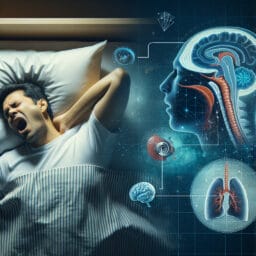
Understanding Sleep Apnea: A Comprehensive Definition and Overview
Table of Contents
- Introduction: Brief overview of Sleep Apnea
- Definition of Sleep Apnea
- Causes of Sleep Apnea
- Symptoms of Sleep Apnea
- Diagnosis of Sleep Apnea
- Treatment for Sleep Apnea
- Managing Sleep Apnea
- Conclusion: Final thoughts and summary of the article
- Frequently Asked Questions
Introduction: Brief overview of Sleep Apnea
Sleep apnea, with its two common forms – obstructive sleep apnea (OSA) and central sleep apnea, is a serious sleep disorder that can severely disrupt restful sleep. A surprising fact is that this condition often goes unnoticed as it primarily occurs when you’re sleeping. OSA, the most common type of sleep apnea, happens when throat muscles relax causing the soft tissue in your throat to collapse, blocking or narrowing the airway while sleeping. This results in periods where someone’s breathing stops or becomes shallow leading to lower blood oxygen levels and increased risk of other medical conditions like high blood pressure and heart failure. Regardless if falling asleep comes easy for you or not, repeated interruptions because your body has to resume breathing prevents you from having uninterrupted REM sleep – a crucial part of our sleep cycle associated with memory consolidation and learning. Engaging qualified healthcare providers would be a step forward in managing these symptoms diagnosis treatment effectively.
Definition of Sleep Apnea
Understanding sleep apnea in depth can aid in early identification and effective management of this sleep disorder. A staggering fact is that many people unknowingly live with either obstructive or central sleep apnea, both forms of a condition that can pose serious health risks if left untreated. Obstructive sleep apnea (OSA) is the more common type where the throat muscles relax leading to soft tissue in the throat collapsing, blocking your airway while you’re sleeping. Central Sleep Apnea (CSA), on the other hand, is not so much about a physical blockage but instead occurs when your brain doesn’t send proper signals to muscles controlling breathing during sleep. In essence, someone’s breathing stops temporarily or becomes very shallow due to these interruptions in communication between brain and body. Ultimately, both types result in lower blood oxygen levels causing one to startle awake – an action necessary for resume breathing but detrimental for achieving restful REM sleep commonly associated with memory consolidation and learning processes. Therefore, it’s crucial to consult with healthcare providers or a sleep specialist if you experience symptoms such as daytime sleepiness, loud snoring or abrupt awakenings followed by gasping or choking; they can conduct a physical exam or even recommend a full-fledged sleep study for accurate diagnosis and personalized treatment options grounded on medical education.
| Type of Sleep Apnea | Description | Effects | Symptoms |
|---|---|---|---|
| Obstructive Sleep Apnea (OSA) | Occurs when the throat muscles relax leading to soft tissue in the throat collapsing, blocking your airway while you’re sleeping. | Results in lower blood oxygen levels causing one to startle awake. Detrimental for achieving restful REM sleep. | Daytime sleepiness, loud snoring or abrupt awakenings followed by gasping or choking. |
| Central Sleep Apnea (CSA) | Occurs when your brain doesn’t send proper signals to muscles controlling breathing during sleep. | One’s breathing stops temporarily or becomes very shallow due to these interruptions in communication between brain and body. Detrimental for achieving restful REM sleep. | Daytime sleepiness, abrupt awakenings; may or may not include snoring. |
Causes of Sleep Apnea
It’s noteworthy that the causes of sleep apnea are multifaceted, with risk factors varying between obstructive sleep apnea (OSA) and central sleep apnea. OSA often results from physical obstructions in the upper airway due to soft tissue collapsing or narrowing when throat muscles relax during sleep. It’s particularly common among those carrying excess weight or having large tonsils — both conditions that can lead to a narrowed airway. Intriguingly, people assigned male at birth and older individuals also seem to run a higher risk of developing this common form of the disorder.
Central Sleep Apnea occurs less frequently but presents its own unique set of triggers. Rather than a physical blockage causing someone’s breathing to stop, it is more an issue of communication: the brain ceases sending proper signals to control breathing while you’re sleeping. This condition is more commonly associated with specific medical conditions such as heart failure or stroke.
Both types of sleep apnea severely disrupt REM sleep and can lead to serious health repercussions like high blood pressure and heart diseases if not diagnosed early by healthcare providers using methods such as a physical exam or even a comprehensive sleep study for accurate symptoms diagnosis treatment. Therefore, understanding these risk factors associated with various types of sleep disorders aids in making informed care decisions before complications arise.
| Type of Sleep Apnea | Causes | Risk Factors | Diagnosis | Possible Repercussions |
|---|---|---|---|---|
| Obstructive Sleep Apnea (OSA) | Physical obstructions in the upper airway due to soft tissue collapsing or narrowing when throat muscles relax during sleep | Excess weight, large tonsils, assigned male at birth, older age | Physical exam, comprehensive sleep study | High blood pressure, heart diseases |
| Central Sleep Apnea | Brain ceases sending proper signals to control breathing while sleeping | Associated with specific medical conditions such as heart failure or stroke | Physical exam, comprehensive sleep study | High blood pressure, heart diseases |
Symptoms of Sleep Apnea
A universal misconception about sleep apnea is that it’s a mere annoyance, a snoring issue that can be shrugged off. However, this common sleep disorder is anything but trivial. The frequent halts in breathing during your slumber when the soft tissue collapses or when the brain fails to signal muscle control for breathing puts immense strain on your body – all while you’re unaware and trying to fall asleep. Struggling to maintain regular respiration results in poor REM sleep quality which further exacerbates daytime fatigue and drowsiness.
Common symptoms of both obstructive and central sleep apnea include episodes when you stop breathing during sleep (reported by another person), abrupt awakenings accompanied by shortness of breath, dry mouth or sore throat upon waking up, insomnia, hypersomnia (excessive daytime drowsiness), attention problems, irritability and morning headaches. Not everyone with sleep apnea experiences these symptoms uniformly; some may not even know they have it until a partner notices their erratic breathing patterns at night causing them distress.
The diagnosis of this complex disorder typically involves a thorough physical exam by a healthcare provider which may lead towards an intricate overnight monitoring via a sleep study for accurate detection of any abnormal respiratory events. This medical education helps tailor the most effective treatment plan considering individual risk factors such as excess weight or family history of heart failure—management strategies range from positive airway pressure devices ensuring constant air pressure inside your nose & mouth to surgeries aimed at reducing obstructions in your upper airway.
These insights underline the importance of early recognition and management of sleep apnea — it’s not just about good rest but more critically, about averting severe health risks like high blood pressure or stroke down the line due to low blood oxygen levels from interrupted breathing during critical REM cycles.
| Common Symptoms of Sleep Apnea |
|---|
| Episodes of stopped breathing during sleep (reported by another person) |
| Abrupt awakenings accompanied by shortness of breath |
| Dry mouth or sore throat upon waking up |
| Insomnia |
| Hypersomnia (excessive daytime drowsiness) |
| Attention problems |
| Irritability |
| Morning headaches |
| Diagnosis and Management Strategies |
| Physical exam by a healthcare provider |
| Overnight monitoring via a sleep study |
| Positive airway pressure devices |
| Surgeries aimed at reducing obstructions in the upper airway |
| Importance of Early Recognition |
| Avoid severe health risks like high blood pressure or stroke from low blood oxygen levels during REM cycles |
Diagnosis of Sleep Apnea
Despite sleep apnea often shrouded in slumber, a thorough diagnosis by a healthcare provider can shine light on this elusive sleep disorder. Central to this process is the role of intricate sleep studies and detailed physical exams. Sleep studies adeptly monitor nighttime respiratory events, evaluating fluctuations in blood oxygen levels and identifying periods where someone’s breathing stops – hallmark signs of both obstructive and central sleep apnea. Moreover, these studies provide invaluable insights into the frequency of such episodes and their impact on one’s REM sleep, crucial for formulating an effective treatment strategy. On a parallel track, a comprehensive physical exam takes into account various risk factors such as excess weight or large tonsils that may contribute to narrowed airways especially during falling asleep when throat muscles naturally relax. Therefore, whether it’s loud snoring disrupting your partner’s slumber or unexplained daytime fatigue stealing away your productivity; rest assured that with early consultation from healthcare providers armed with medical education about sleep disorders like OSA & CSA, you do not have to navigate these troubled waters alone. Diagnosis is the first stride towards reclaiming your nights from obstructive or central sleep apnea and restoring your days back under the sun!
Treatment for Sleep Apnea
It’s an intriguing fact that many people suffering from sleep apnea have yet to receive a diagnosis, often mistaking it for mere snoring or daytime fatigue. However, this common sleep disorder has the potential to severely impact one’s health and quality of life if left untreated. The silver lining in this cloud is that several effective treatment options are available once accurately diagnosed by a healthcare provider through methods such as physical exams and comprehensive sleep studies. Options might involve positive airway pressure devices which ensure constant air pressure inside your nose & mouth during sleep, preventing the soft tissue in your throat from collapsing; an event that obstructs the upper airway leading to interruptions in breathing while you’re sleeping. Alternatively, lifestyle changes including weight loss and avoidance of alcohol can reduce risk factors associated with severe sleep apnea such as high blood pressure or heart failure. In certain cases, surgeries aimed at reducing obstructions in your upper airway could be recommended depending on individual conditions and needs. It is essential to remember that early diagnosis by healthcare providers via thorough medical education plays a crucial role in determining the most suitable treatment plan for managing symptoms effectively.
Managing Sleep Apnea
Adopting lifestyle modifications can play a pivotal role in managing sleep apnea, whether it’s the common form called Obstructive Sleep Apnoea (OSA) or the less frequent Central Sleep Apnea. For instance, shedding excess weight may help reduce symptoms by narrowing the airway less when throat muscles relax during sleep. Avoiding alcohol, which can cause soft tissue in your throat to collapse more readily, is another proactive step towards alleviating this sleep disorder. Regular physical activity not only aids weight loss but also promotes better quality of REM sleep which often gets disrupted when someone’s breathing stops due to blocked airways or non-communicating brain signals controlling breathing. Furthermore, positioning yourself on your side while falling asleep could potentially deter large tonsils from causing obstructions in the upper airway at night; a key risk factor for OSA especially among people assigned male at birth. A healthcare provider or a sleep specialist can conduct comprehensive physical exams or recommend thorough sleep studies that give insights into your unique condition and guide personalized care decisions for effective management of this condition.
Conclusion: Final thoughts and summary of the article
Comprehending sleep apnea, its causes, symptoms and treatment is crucial due to its capacity to severely disrupt REM sleep and escalate the risk of medical conditions like high blood pressure and heart failure. As we delve into this common but often overlooked sleep disorder, it becomes evident that ‘falling asleep’ isn’t always as simple as it sounds. Whether obstructive sleep apnea (OSA) or central sleep apnea (CSA), individuals experience periodic cessation in breathing – triggered either by relaxed throat muscles leading to soft tissue collapse or the brain’s failure to signal vital breathing control during slumber. While these disturbances may go unnoticed at night, daytime symptoms such as excessive sleepiness and attention problems are red flags warranting a consultation with a healthcare provider. Armed with medical education about the complex dynamics of various forms of this disorder including OSA & CSA, they can perform accurate physical exams or recommend comprehensive sleep studies for effective diagnosis which is key in navigating towards appropriate treatment – be it positive airway pressure devices maintaining steady air pressure inside nose & mouth while you’re sleeping or lifestyle modifications reducing risk factors such as excess weight or alcohol consumption. This journey of understanding underscores the importance not just for good rest but more critically, for averting serious health risks associated with low blood oxygen levels from constant interruptions caused by this disruptive condition known commonly as Sleep Apnea.


